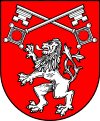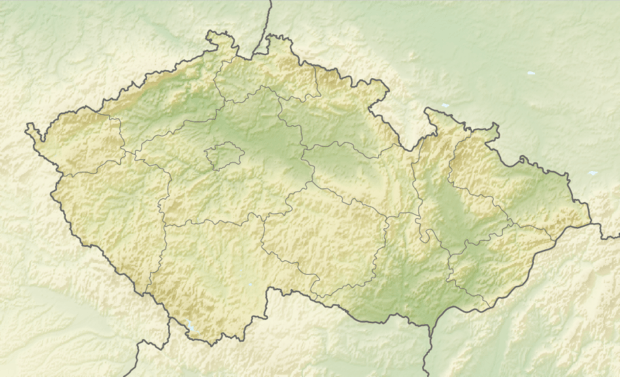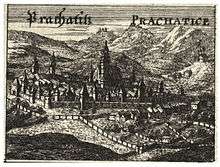Prachatice
Prachatice (Czech pronunciation: [ˈpraxacɪtsɛ]; German: Prachatitz) is a town in the South Bohemian Region, Czech Republic.
Prachatice | |
|---|---|
Town | |
Town square with the town hall | |
 Flag  Coat of arms | |
 Prachatice Location in the Czech Republic | |
| Coordinates: 49°0′47″N 13°59′51″E | |
| Country | Czech Republic |
| Region | South Bohemian |
| District | Prachatice |
| Founded | 11th century |
| Government | |
| • Mayor | Martin Malý |
| Area | |
| • Total | 38.90 km2 (15.02 sq mi) |
| Elevation | 561 m (1,841 ft) |
| Population (2019-01-01[1]) | |
| • Total | 10,874 |
| • Density | 280/km2 (720/sq mi) |
| Time zone | UTC+1 (CET) |
| • Summer (DST) | UTC+2 (CEST) |
| Postal code | 383 01 |
| Website | www.prachatice.cz |
History
The town of Prachatice has its origins in the 11th century, following the beginning of trade on the Golden Path (an important salt trade route beginning in Passau, Bavaria). The property on which the town now stands was initially part of the domain of Vyšehrad and first came to prominence when the domain's provost purchased the right to impose a toll on traffic on the Golden Path. The settlement later grew in importance when, in the 13th century, it was granted the right to store the salt that was traded on the Golden Path. This privilege made Prachatice the only town in Southern Bohemia that could buy the salt that was sent out of Passau.
During the Hussite Wars of the 15th century, Prachatice was attacked twice and eventually conquered by the Hussites who killed most of the population of the town. After the end of the conflict, in 1436, Prachatice was granted the status of royal town. Only one year later the town was offered as collateral to Jan Smil of Krems by King Zikmund (Sigismund, Holy Roman Emperor), but fell under the control of the House of Rožmberk for a short period following Smil's execution in 1439 at Český Krumlov. Oldřich of Rožmberk sold the town of Prachatice almost immediately after the execution but it again became property of the family in 1501.
The Rožmberks controlled Prachatice through its most prosperous period until 1601 when Petr Vok, the last member of the family, sold the town to Emperor Rudolf II who would again make it a royal town. It remained firmly under royal control until the Rebellion of the Bohemian Estates during which it sided with the rebels. However, in 1620 the town was reconquered by the Imperial commander Charles Bonaventure de Longueval, Count of Bucquoy who ordered many of its citizens to be slaughtered and a large ransom to be paid to the emperor.
After the Battle of White Mountain the town lost its status and privileges and became the property of the Eggenberg family, though the emperor's troops remained in the city throughout the remainder of the Thirty Years' War. Later on in the war the city was conquered by the Swedish army and another large ransom was demanded.

The town changed hands again in 1719, following the death of Princess Marie Arnoštka of Eggenberg, this time coming under the control of the affluent Schwarzenberg family.
Until 1918 the town was part of the Austrian monarchy (Austrian side after the compromise of 1867), in the district of the same name, one of the 94 Bezirkshauptmannschaften in Bohemia.[2]
In March 1939, a film at the Passau Nibelungenhalle featured the Angliederung of Prachatice into Bayerische Ostmark.[3]
After 1945 the German population was expelled as a result of WW II.
Historical population
1869: 4,911 inhabitants
1900: 5,573
1930: 5,926
1950: 5,130
1961: 5,381
1970: 7,100
1980: 10,354
1991: 11,805
2001: 11,977
Prachatice today
The historical character of the city center has been protected since 1981.
The dominating industries are machine engineering, electrotechnical industry and timber processing. A new industrial zone has been built.
Notable people
- Křišťan of Prachatice
- John Neumann, first American male saint, born in 1811
- Josef Messner (1822–1862), writer
- Adolf Zika, photographer
- Jiří Fried[4]
Residents
- Jan Hus
- Irma Krützner, writer and poet, lived here in 1915–1946
- Leo Vaniš, educator[5]
- Otakar Ševčík
- See also detailed list.
Main sights
- Town hall (Stará radnice)
- Church of St. James (Kostel svatého Jakuba)
Twin towns — sister cities
Prachatice is twinned with:[6]
References
- "Population of municipalities of the Czech republic". Czech Statistical Office. Retrieved 2019-04-30.
- Die postalischen Abstempelungen auf den österreichischen Postwertzeichen-Ausgaben 1867, 1883 und 1890, Wilhelm KLEIN, 1967
- Anna Rosmus Hitlers Nibelungen, Samples Grafenau 2015, pp. 196f
- cs:Jiří Fried
- cs:Leo Vaniš (1936)
- "Partnerská města" (in Czech). Město Prachatice. Retrieved 2019-08-23.
External links
- Municipal website (in Czech) English version (in English)
- Details of early town history (in Czech)
- Region of Prachatice (in English)
- Prachatice (in English) - basic facts, history, sights, one-day trips
- Kratochvile Château (in English) - general info, history, exhibitions, opening hours, prices
| Wikimedia Commons has media related to Prachatice. |